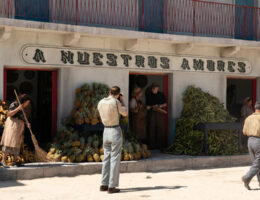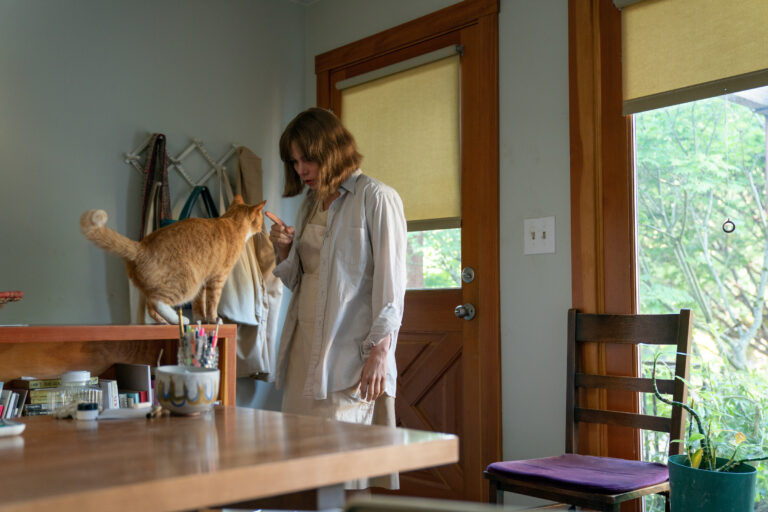Showing Up (2023 | USA | 108 minutes | Kelly Reichardt)
In their fourth collaboration, director Kelly Reichardt and Michelle Williams reunite to bring a sensitively-rendered portrait of a working artist to the screen. Cinema is typically more interested in depictions of budding geniuses, dramatically troubled, foolishly unrecognized who go on to break history with blockbuster shows, but that’s never been Reichardt’s territory. Instead, working from a script written with frequent collaborator Jon Raymond, she centers the narrative in present-day Portland in the week leading up to a working ceramicist’s show at a neighborhood gallery show. What the film eschews in terms of fireworks are easily lifted by the rich textures that it observes.
Michelle Williams, in a short brown bob, wearing white crocs and flowing Portlandia-approved natural textiles, and with none of the affectations of recent performances (like the artistic mother in The Fabelmans) plays Lizzy. Sculpting primitively rustic tabletop figures of women in whimsical poses is how she spends her evenings in the garage studio under her modest duplex. She shares her home with a frisky orange tabby cat and shares a central wall with her friend Jo, who’s both a fellow artist and her frequently-distracted landlord. Her work with clay doesn’t pay the bills, though. Instead she spends her days behind a desk at the idyllic art school where she got her training, that also happens to be run by her mother (Maryann Plunkett who brings dry comedy to the divide between family and workplace).
Filmed at the recently shuttered Oregon College of Art and Craft, the milieu is rich for exploration. We watch along with Lizzie as the idealistic students develop their craft, be it textiles, performance, filmmaking, pottery, or studio art. From tracking shots of boisterous creativity to the quiet intimacy of perfecting small details, the film revels in the universal ASMR-like fascination of watching people work with their hands to accomplish tasks. Reichardt captures both the boundless enthusiasm of youth as well as the subtle gulf between the recent graduate taking her lunch break out of tupperware and the still-unencumbered students who explore their passions in an eternally summer-camplike setting. The dynamics are further rippled by the presence of a highly successful artist in residence as well as the school’s plans to spotlight Jo’s recent large-scale sculptural work at an alumni show.
The primary drama isn’t whether Lizzy will finish her show in time or get rich off her gallery show. Instead, it’s often about all the stuff that happens when she isn’t making art. There’s a subtle look at the economic disparities at play between one artist who’s a renter vs. her landlord friend who co-owns the place via the goodwill of parents with resources to buy a duplex when property values dipped. Although they’re longtime friends, friction develops in the days leading to Lizzy’s show as one artist struggles to find time to do her work and the other can’t find time to fix a broken water heater so that her neighbor can finally get a hot shower.
Lizzy’s attentions are not only divided by her work and her craft. She’s the member of her scattered family who takes the time to check in on others. She worries after her retired artist dad (another low-screen time, high-impact appearance from Judd Hirsch) when his hospitality is stretched by the hilarious pair of drifters who’ve seemingly taken over his house. She keeps an eye on her paranoid brother (John Magaro, making another splash in a Reichardt film) whose “genius” allowed his parents to brush aside mental health issues as he’s loosely observed by a gawky but grounded neighbor (always nice to see Theo Taplitz from Little Men). Magaro’s wonderful in the role, not stretching the paranoid quirks too far, but portraying real pathos when he begins a disruptive land-based art project in his backyard to honor the poetry of the earth.
As if the family concerns weren’t enough, that pesky cat introduces the film’s most quirky sideplot: an injured scene-stealer of a pigeon, whose care and recovery becomes a central focus of the plot. Lizzy and Joe trade shifts with the broken bird, who traverses the film Groggu-like in a well-appointed shoebox, much to the surprise of students at the school (“In Tacoma, we shoot pigeons!”) and the oft-exiled unhappy tabby.
Through this all, we watch Lizzie’s work develop, both through her own hands and through the mystical firing process supervised by André Benjamin’s kiln master (the actor’s also contributes flute to the spare score). Williams communicates the slow-mounting stress as the days tick away toward the modest show. While the film hints at possibility of a break from a visiting gallerist, it’s really not that kind of movie. Its aims are both lighter and more serious, observing Lizzie as she watches others view her work and her scattered family coming together. Endings are tricky, but Reichardt has made one of the year’s best and it concludes with delicate optimism. While the film invites us to wonder what drives Lizzie to continue creating art, it is also acutely persuasive in demonstrating the value in, yes, actually showing up.
Showing Up is now playing in Seattle at the Regal Meridian and will have a run at the Grand Illusion next month.
Lead image courtesy A24.




